Assessing the Infringements, Resolution and Effects
VerifiedAdded on 2019/10/01
|11
|3169
|136
Report
AI Summary
The organization can use a risk-based assessment approach to ensure quality assurance and contingency planning. It is crucial for sales employees to understand the organization's legal, regulatory, ethical, and social policies to avoid non-compliance issues. The report highlights the importance of consumer protection rights and clear codes of practices. Additionally, it emphasizes the need for proactive and reactive responses to rectify problematic situations.
Contribute Materials
Your contribution can guide someone’s learning journey. Share your
documents today.
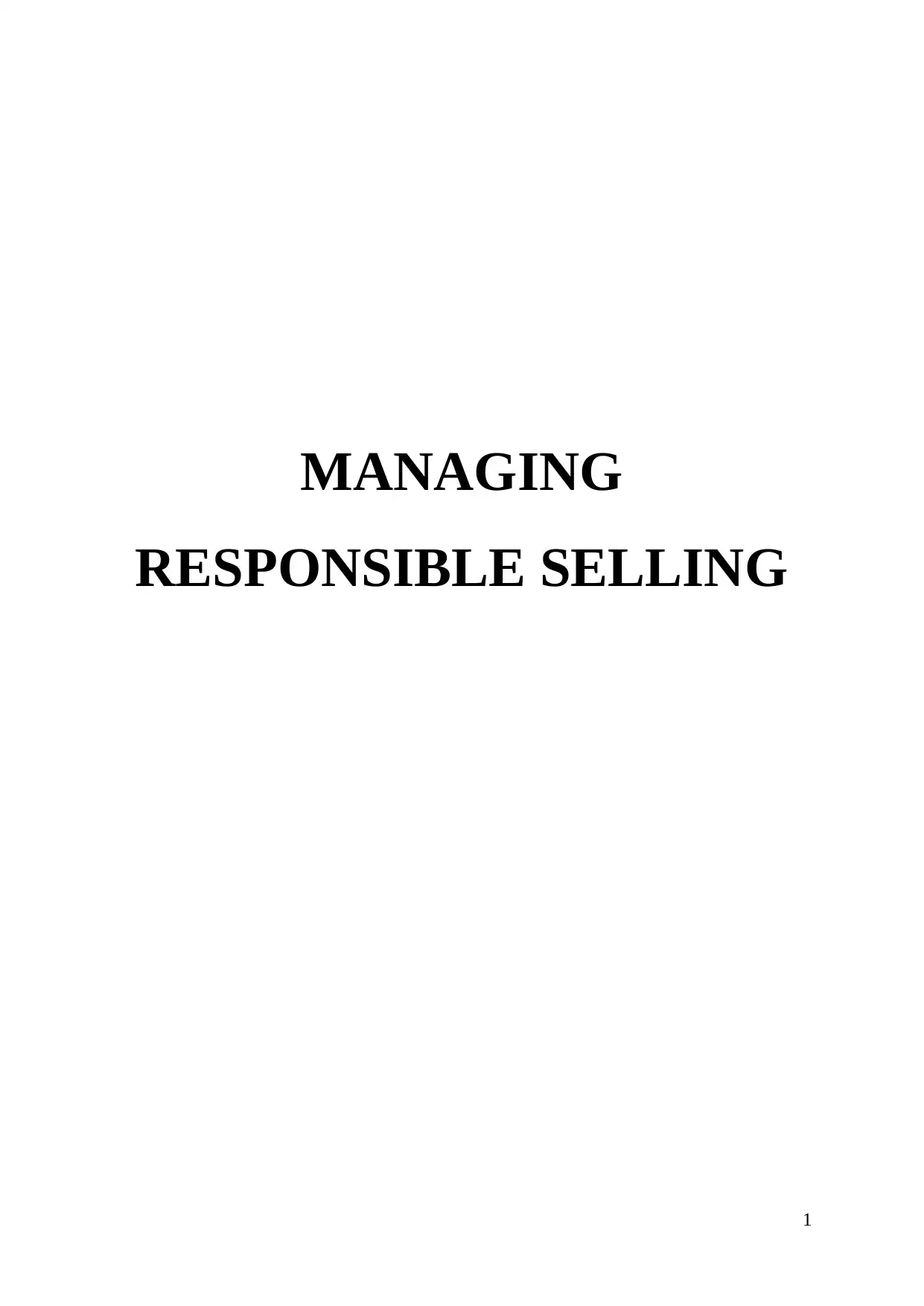
MANAGING
RESPONSIBLE SELLING
1
RESPONSIBLE SELLING
1
Secure Best Marks with AI Grader
Need help grading? Try our AI Grader for instant feedback on your assignments.
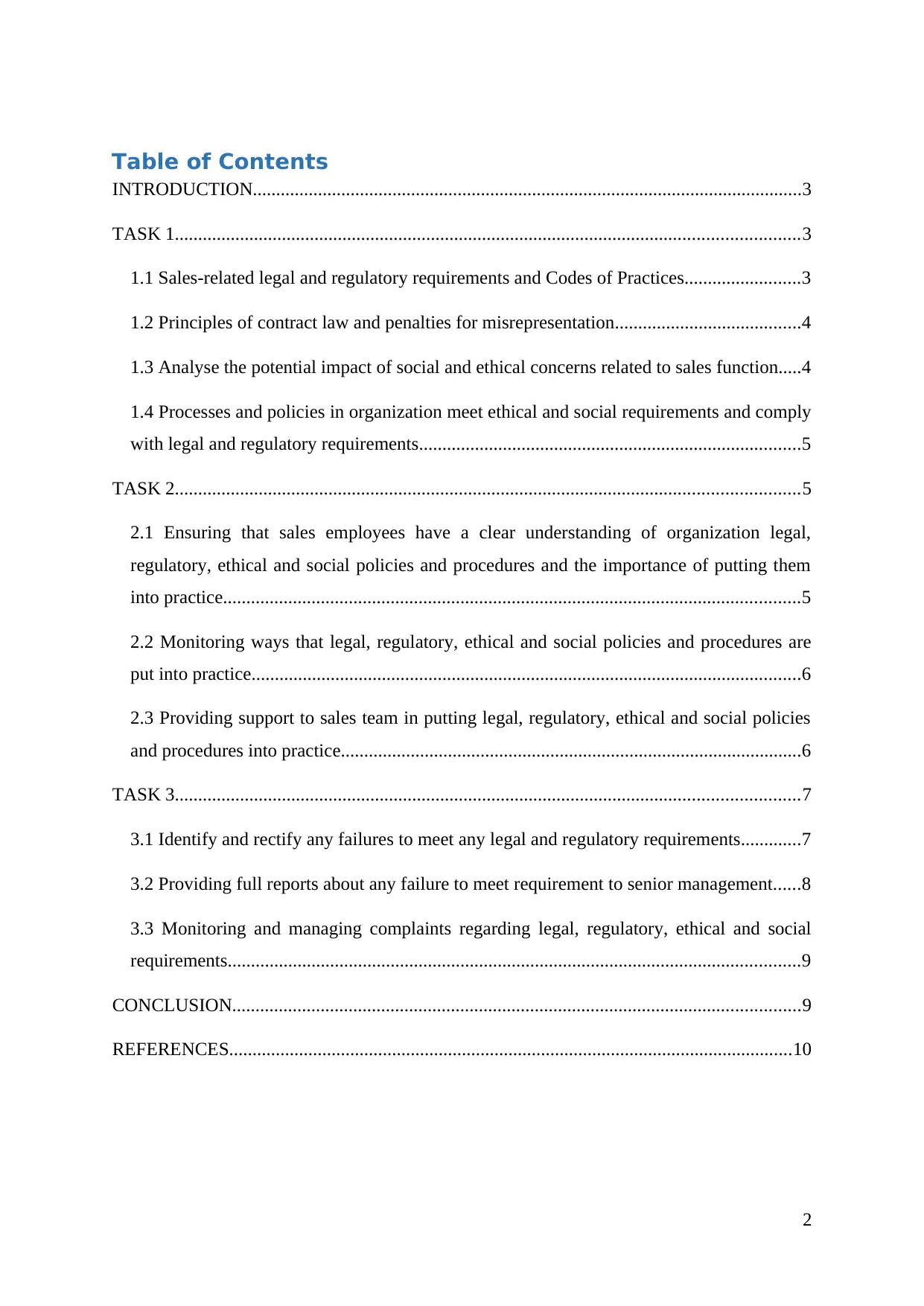
Table of Contents
INTRODUCTION......................................................................................................................3
TASK 1......................................................................................................................................3
1.1 Sales-related legal and regulatory requirements and Codes of Practices.........................3
1.2 Principles of contract law and penalties for misrepresentation........................................4
1.3 Analyse the potential impact of social and ethical concerns related to sales function.....4
1.4 Processes and policies in organization meet ethical and social requirements and comply
with legal and regulatory requirements..................................................................................5
TASK 2......................................................................................................................................5
2.1 Ensuring that sales employees have a clear understanding of organization legal,
regulatory, ethical and social policies and procedures and the importance of putting them
into practice............................................................................................................................5
2.2 Monitoring ways that legal, regulatory, ethical and social policies and procedures are
put into practice......................................................................................................................6
2.3 Providing support to sales team in putting legal, regulatory, ethical and social policies
and procedures into practice...................................................................................................6
TASK 3......................................................................................................................................7
3.1 Identify and rectify any failures to meet any legal and regulatory requirements.............7
3.2 Providing full reports about any failure to meet requirement to senior management......8
3.3 Monitoring and managing complaints regarding legal, regulatory, ethical and social
requirements...........................................................................................................................9
CONCLUSION..........................................................................................................................9
REFERENCES.........................................................................................................................10
2
INTRODUCTION......................................................................................................................3
TASK 1......................................................................................................................................3
1.1 Sales-related legal and regulatory requirements and Codes of Practices.........................3
1.2 Principles of contract law and penalties for misrepresentation........................................4
1.3 Analyse the potential impact of social and ethical concerns related to sales function.....4
1.4 Processes and policies in organization meet ethical and social requirements and comply
with legal and regulatory requirements..................................................................................5
TASK 2......................................................................................................................................5
2.1 Ensuring that sales employees have a clear understanding of organization legal,
regulatory, ethical and social policies and procedures and the importance of putting them
into practice............................................................................................................................5
2.2 Monitoring ways that legal, regulatory, ethical and social policies and procedures are
put into practice......................................................................................................................6
2.3 Providing support to sales team in putting legal, regulatory, ethical and social policies
and procedures into practice...................................................................................................6
TASK 3......................................................................................................................................7
3.1 Identify and rectify any failures to meet any legal and regulatory requirements.............7
3.2 Providing full reports about any failure to meet requirement to senior management......8
3.3 Monitoring and managing complaints regarding legal, regulatory, ethical and social
requirements...........................................................................................................................9
CONCLUSION..........................................................................................................................9
REFERENCES.........................................................................................................................10
2
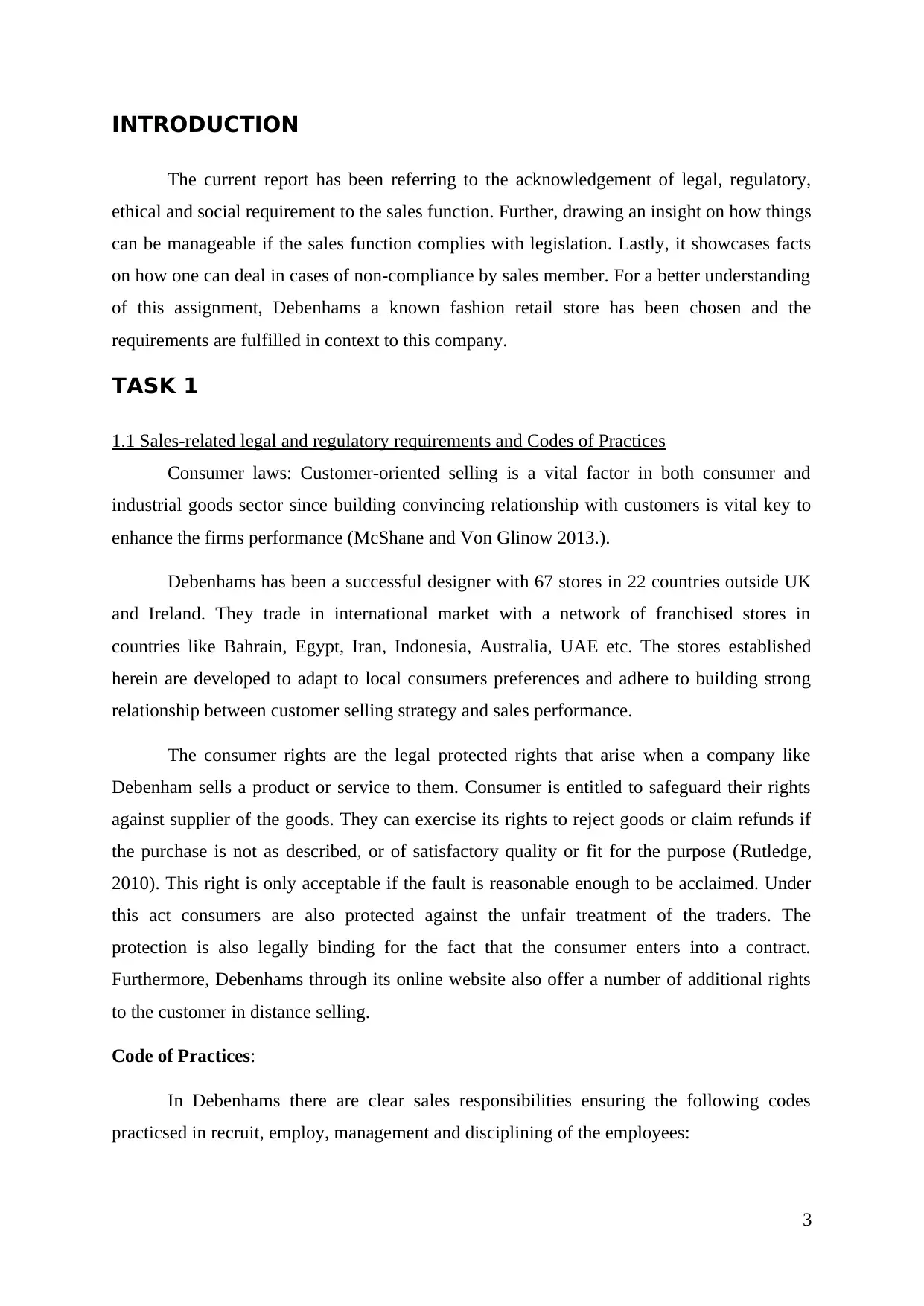
INTRODUCTION
The current report has been referring to the acknowledgement of legal, regulatory,
ethical and social requirement to the sales function. Further, drawing an insight on how things
can be manageable if the sales function complies with legislation. Lastly, it showcases facts
on how one can deal in cases of non-compliance by sales member. For a better understanding
of this assignment, Debenhams a known fashion retail store has been chosen and the
requirements are fulfilled in context to this company.
TASK 1
1.1 Sales-related legal and regulatory requirements and Codes of Practices
Consumer laws: Customer-oriented selling is a vital factor in both consumer and
industrial goods sector since building convincing relationship with customers is vital key to
enhance the firms performance (McShane and Von Glinow 2013.).
Debenhams has been a successful designer with 67 stores in 22 countries outside UK
and Ireland. They trade in international market with a network of franchised stores in
countries like Bahrain, Egypt, Iran, Indonesia, Australia, UAE etc. The stores established
herein are developed to adapt to local consumers preferences and adhere to building strong
relationship between customer selling strategy and sales performance.
The consumer rights are the legal protected rights that arise when a company like
Debenham sells a product or service to them. Consumer is entitled to safeguard their rights
against supplier of the goods. They can exercise its rights to reject goods or claim refunds if
the purchase is not as described, or of satisfactory quality or fit for the purpose (Rutledge,
2010). This right is only acceptable if the fault is reasonable enough to be acclaimed. Under
this act consumers are also protected against the unfair treatment of the traders. The
protection is also legally binding for the fact that the consumer enters into a contract.
Furthermore, Debenhams through its online website also offer a number of additional rights
to the customer in distance selling.
Code of Practices:
In Debenhams there are clear sales responsibilities ensuring the following codes
practicsed in recruit, employ, management and disciplining of the employees:
3
The current report has been referring to the acknowledgement of legal, regulatory,
ethical and social requirement to the sales function. Further, drawing an insight on how things
can be manageable if the sales function complies with legislation. Lastly, it showcases facts
on how one can deal in cases of non-compliance by sales member. For a better understanding
of this assignment, Debenhams a known fashion retail store has been chosen and the
requirements are fulfilled in context to this company.
TASK 1
1.1 Sales-related legal and regulatory requirements and Codes of Practices
Consumer laws: Customer-oriented selling is a vital factor in both consumer and
industrial goods sector since building convincing relationship with customers is vital key to
enhance the firms performance (McShane and Von Glinow 2013.).
Debenhams has been a successful designer with 67 stores in 22 countries outside UK
and Ireland. They trade in international market with a network of franchised stores in
countries like Bahrain, Egypt, Iran, Indonesia, Australia, UAE etc. The stores established
herein are developed to adapt to local consumers preferences and adhere to building strong
relationship between customer selling strategy and sales performance.
The consumer rights are the legal protected rights that arise when a company like
Debenham sells a product or service to them. Consumer is entitled to safeguard their rights
against supplier of the goods. They can exercise its rights to reject goods or claim refunds if
the purchase is not as described, or of satisfactory quality or fit for the purpose (Rutledge,
2010). This right is only acceptable if the fault is reasonable enough to be acclaimed. Under
this act consumers are also protected against the unfair treatment of the traders. The
protection is also legally binding for the fact that the consumer enters into a contract.
Furthermore, Debenhams through its online website also offer a number of additional rights
to the customer in distance selling.
Code of Practices:
In Debenhams there are clear sales responsibilities ensuring the following codes
practicsed in recruit, employ, management and disciplining of the employees:
3
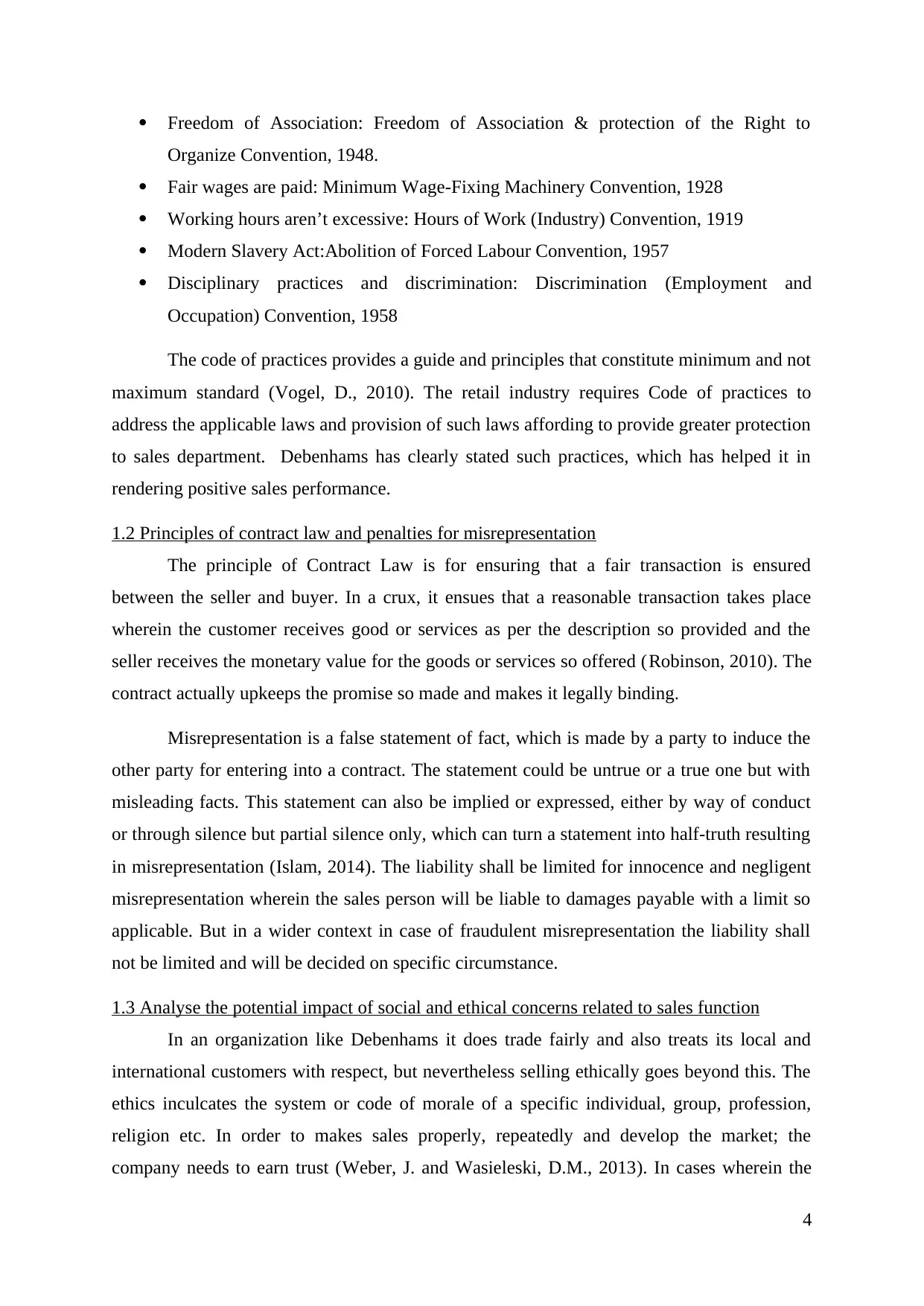
Freedom of Association: Freedom of Association & protection of the Right to
Organize Convention, 1948.
Fair wages are paid: Minimum Wage-Fixing Machinery Convention, 1928
Working hours aren’t excessive: Hours of Work (Industry) Convention, 1919
Modern Slavery Act:Abolition of Forced Labour Convention, 1957
Disciplinary practices and discrimination: Discrimination (Employment and
Occupation) Convention, 1958
The code of practices provides a guide and principles that constitute minimum and not
maximum standard (Vogel, D., 2010). The retail industry requires Code of practices to
address the applicable laws and provision of such laws affording to provide greater protection
to sales department. Debenhams has clearly stated such practices, which has helped it in
rendering positive sales performance.
1.2 Principles of contract law and penalties for misrepresentation
The principle of Contract Law is for ensuring that a fair transaction is ensured
between the seller and buyer. In a crux, it ensues that a reasonable transaction takes place
wherein the customer receives good or services as per the description so provided and the
seller receives the monetary value for the goods or services so offered (Robinson, 2010). The
contract actually upkeeps the promise so made and makes it legally binding.
Misrepresentation is a false statement of fact, which is made by a party to induce the
other party for entering into a contract. The statement could be untrue or a true one but with
misleading facts. This statement can also be implied or expressed, either by way of conduct
or through silence but partial silence only, which can turn a statement into half-truth resulting
in misrepresentation (Islam, 2014). The liability shall be limited for innocence and negligent
misrepresentation wherein the sales person will be liable to damages payable with a limit so
applicable. But in a wider context in case of fraudulent misrepresentation the liability shall
not be limited and will be decided on specific circumstance.
1.3 Analyse the potential impact of social and ethical concerns related to sales function
In an organization like Debenhams it does trade fairly and also treats its local and
international customers with respect, but nevertheless selling ethically goes beyond this. The
ethics inculcates the system or code of morale of a specific individual, group, profession,
religion etc. In order to makes sales properly, repeatedly and develop the market; the
company needs to earn trust (Weber, J. and Wasieleski, D.M., 2013). In cases wherein the
4
Organize Convention, 1948.
Fair wages are paid: Minimum Wage-Fixing Machinery Convention, 1928
Working hours aren’t excessive: Hours of Work (Industry) Convention, 1919
Modern Slavery Act:Abolition of Forced Labour Convention, 1957
Disciplinary practices and discrimination: Discrimination (Employment and
Occupation) Convention, 1958
The code of practices provides a guide and principles that constitute minimum and not
maximum standard (Vogel, D., 2010). The retail industry requires Code of practices to
address the applicable laws and provision of such laws affording to provide greater protection
to sales department. Debenhams has clearly stated such practices, which has helped it in
rendering positive sales performance.
1.2 Principles of contract law and penalties for misrepresentation
The principle of Contract Law is for ensuring that a fair transaction is ensured
between the seller and buyer. In a crux, it ensues that a reasonable transaction takes place
wherein the customer receives good or services as per the description so provided and the
seller receives the monetary value for the goods or services so offered (Robinson, 2010). The
contract actually upkeeps the promise so made and makes it legally binding.
Misrepresentation is a false statement of fact, which is made by a party to induce the
other party for entering into a contract. The statement could be untrue or a true one but with
misleading facts. This statement can also be implied or expressed, either by way of conduct
or through silence but partial silence only, which can turn a statement into half-truth resulting
in misrepresentation (Islam, 2014). The liability shall be limited for innocence and negligent
misrepresentation wherein the sales person will be liable to damages payable with a limit so
applicable. But in a wider context in case of fraudulent misrepresentation the liability shall
not be limited and will be decided on specific circumstance.
1.3 Analyse the potential impact of social and ethical concerns related to sales function
In an organization like Debenhams it does trade fairly and also treats its local and
international customers with respect, but nevertheless selling ethically goes beyond this. The
ethics inculcates the system or code of morale of a specific individual, group, profession,
religion etc. In order to makes sales properly, repeatedly and develop the market; the
company needs to earn trust (Weber, J. and Wasieleski, D.M., 2013). In cases wherein the
4
Secure Best Marks with AI Grader
Need help grading? Try our AI Grader for instant feedback on your assignments.
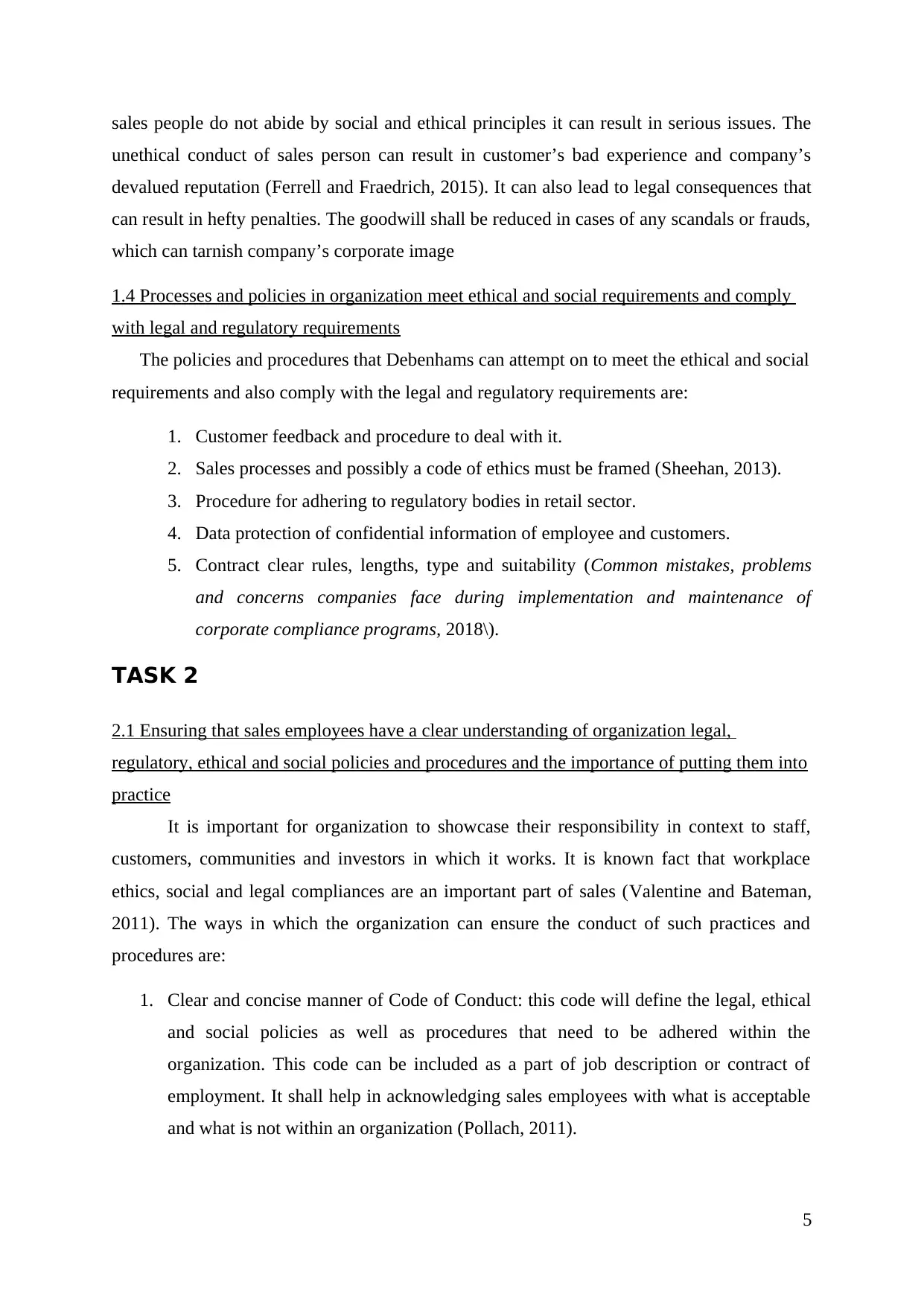
sales people do not abide by social and ethical principles it can result in serious issues. The
unethical conduct of sales person can result in customer’s bad experience and company’s
devalued reputation (Ferrell and Fraedrich, 2015). It can also lead to legal consequences that
can result in hefty penalties. The goodwill shall be reduced in cases of any scandals or frauds,
which can tarnish company’s corporate image
1.4 Processes and policies in organization meet ethical and social requirements and comply
with legal and regulatory requirements
The policies and procedures that Debenhams can attempt on to meet the ethical and social
requirements and also comply with the legal and regulatory requirements are:
1. Customer feedback and procedure to deal with it.
2. Sales processes and possibly a code of ethics must be framed (Sheehan, 2013).
3. Procedure for adhering to regulatory bodies in retail sector.
4. Data protection of confidential information of employee and customers.
5. Contract clear rules, lengths, type and suitability (Common mistakes, problems
and concerns companies face during implementation and maintenance of
corporate compliance programs, 2018\).
TASK 2
2.1 Ensuring that sales employees have a clear understanding of organization legal,
regulatory, ethical and social policies and procedures and the importance of putting them into
practice
It is important for organization to showcase their responsibility in context to staff,
customers, communities and investors in which it works. It is known fact that workplace
ethics, social and legal compliances are an important part of sales (Valentine and Bateman,
2011). The ways in which the organization can ensure the conduct of such practices and
procedures are:
1. Clear and concise manner of Code of Conduct: this code will define the legal, ethical
and social policies as well as procedures that need to be adhered within the
organization. This code can be included as a part of job description or contract of
employment. It shall help in acknowledging sales employees with what is acceptable
and what is not within an organization (Pollach, 2011).
5
unethical conduct of sales person can result in customer’s bad experience and company’s
devalued reputation (Ferrell and Fraedrich, 2015). It can also lead to legal consequences that
can result in hefty penalties. The goodwill shall be reduced in cases of any scandals or frauds,
which can tarnish company’s corporate image
1.4 Processes and policies in organization meet ethical and social requirements and comply
with legal and regulatory requirements
The policies and procedures that Debenhams can attempt on to meet the ethical and social
requirements and also comply with the legal and regulatory requirements are:
1. Customer feedback and procedure to deal with it.
2. Sales processes and possibly a code of ethics must be framed (Sheehan, 2013).
3. Procedure for adhering to regulatory bodies in retail sector.
4. Data protection of confidential information of employee and customers.
5. Contract clear rules, lengths, type and suitability (Common mistakes, problems
and concerns companies face during implementation and maintenance of
corporate compliance programs, 2018\).
TASK 2
2.1 Ensuring that sales employees have a clear understanding of organization legal,
regulatory, ethical and social policies and procedures and the importance of putting them into
practice
It is important for organization to showcase their responsibility in context to staff,
customers, communities and investors in which it works. It is known fact that workplace
ethics, social and legal compliances are an important part of sales (Valentine and Bateman,
2011). The ways in which the organization can ensure the conduct of such practices and
procedures are:
1. Clear and concise manner of Code of Conduct: this code will define the legal, ethical
and social policies as well as procedures that need to be adhered within the
organization. This code can be included as a part of job description or contract of
employment. It shall help in acknowledging sales employees with what is acceptable
and what is not within an organization (Pollach, 2011).
5
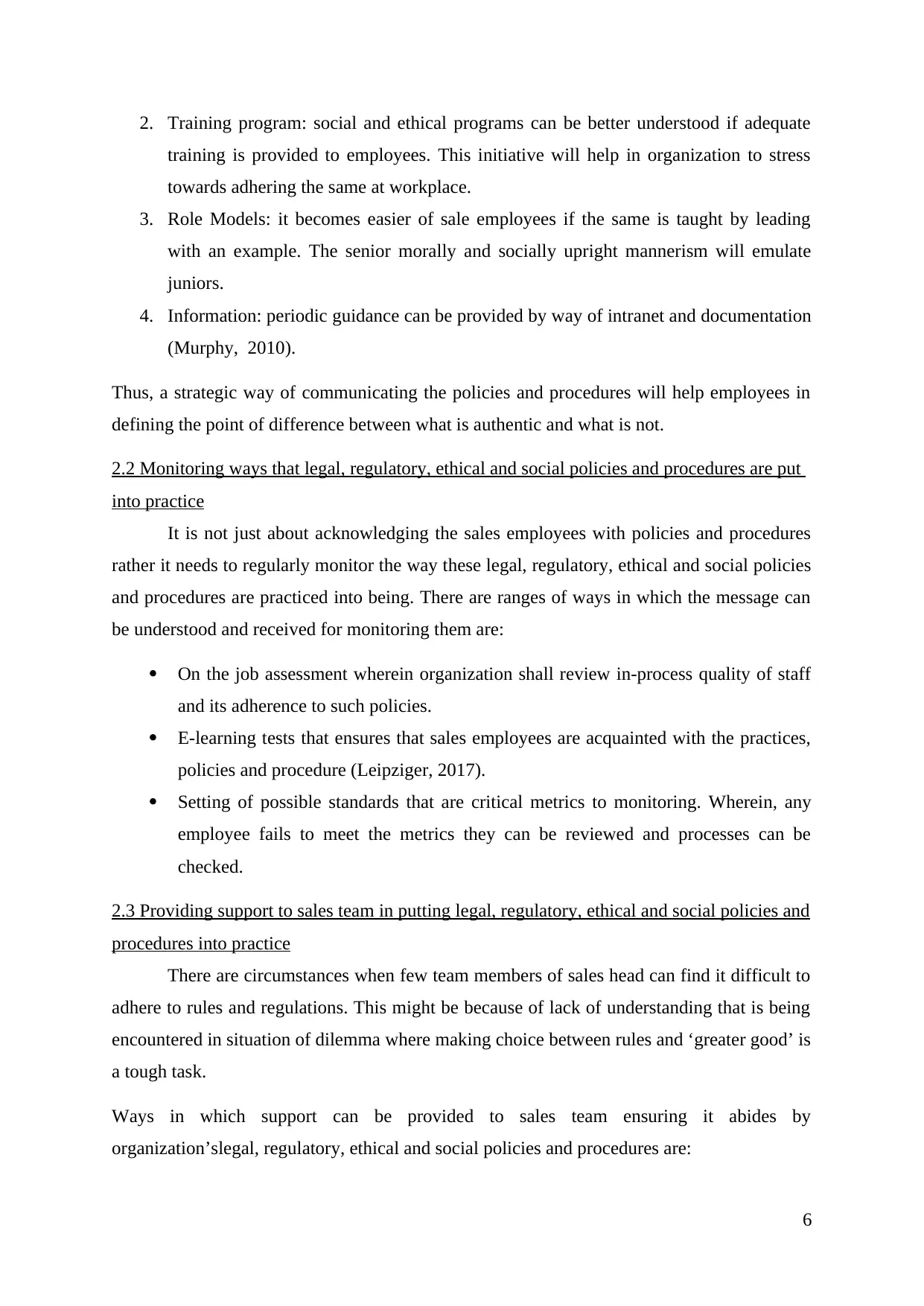
2. Training program: social and ethical programs can be better understood if adequate
training is provided to employees. This initiative will help in organization to stress
towards adhering the same at workplace.
3. Role Models: it becomes easier of sale employees if the same is taught by leading
with an example. The senior morally and socially upright mannerism will emulate
juniors.
4. Information: periodic guidance can be provided by way of intranet and documentation
(Murphy, 2010).
Thus, a strategic way of communicating the policies and procedures will help employees in
defining the point of difference between what is authentic and what is not.
2.2 Monitoring ways that legal, regulatory, ethical and social policies and procedures are put
into practice
It is not just about acknowledging the sales employees with policies and procedures
rather it needs to regularly monitor the way these legal, regulatory, ethical and social policies
and procedures are practiced into being. There are ranges of ways in which the message can
be understood and received for monitoring them are:
On the job assessment wherein organization shall review in-process quality of staff
and its adherence to such policies.
E-learning tests that ensures that sales employees are acquainted with the practices,
policies and procedure (Leipziger, 2017).
Setting of possible standards that are critical metrics to monitoring. Wherein, any
employee fails to meet the metrics they can be reviewed and processes can be
checked.
2.3 Providing support to sales team in putting legal, regulatory, ethical and social policies and
procedures into practice
There are circumstances when few team members of sales head can find it difficult to
adhere to rules and regulations. This might be because of lack of understanding that is being
encountered in situation of dilemma where making choice between rules and ‘greater good’ is
a tough task.
Ways in which support can be provided to sales team ensuring it abides by
organization’slegal, regulatory, ethical and social policies and procedures are:
6
training is provided to employees. This initiative will help in organization to stress
towards adhering the same at workplace.
3. Role Models: it becomes easier of sale employees if the same is taught by leading
with an example. The senior morally and socially upright mannerism will emulate
juniors.
4. Information: periodic guidance can be provided by way of intranet and documentation
(Murphy, 2010).
Thus, a strategic way of communicating the policies and procedures will help employees in
defining the point of difference between what is authentic and what is not.
2.2 Monitoring ways that legal, regulatory, ethical and social policies and procedures are put
into practice
It is not just about acknowledging the sales employees with policies and procedures
rather it needs to regularly monitor the way these legal, regulatory, ethical and social policies
and procedures are practiced into being. There are ranges of ways in which the message can
be understood and received for monitoring them are:
On the job assessment wherein organization shall review in-process quality of staff
and its adherence to such policies.
E-learning tests that ensures that sales employees are acquainted with the practices,
policies and procedure (Leipziger, 2017).
Setting of possible standards that are critical metrics to monitoring. Wherein, any
employee fails to meet the metrics they can be reviewed and processes can be
checked.
2.3 Providing support to sales team in putting legal, regulatory, ethical and social policies and
procedures into practice
There are circumstances when few team members of sales head can find it difficult to
adhere to rules and regulations. This might be because of lack of understanding that is being
encountered in situation of dilemma where making choice between rules and ‘greater good’ is
a tough task.
Ways in which support can be provided to sales team ensuring it abides by
organization’slegal, regulatory, ethical and social policies and procedures are:
6
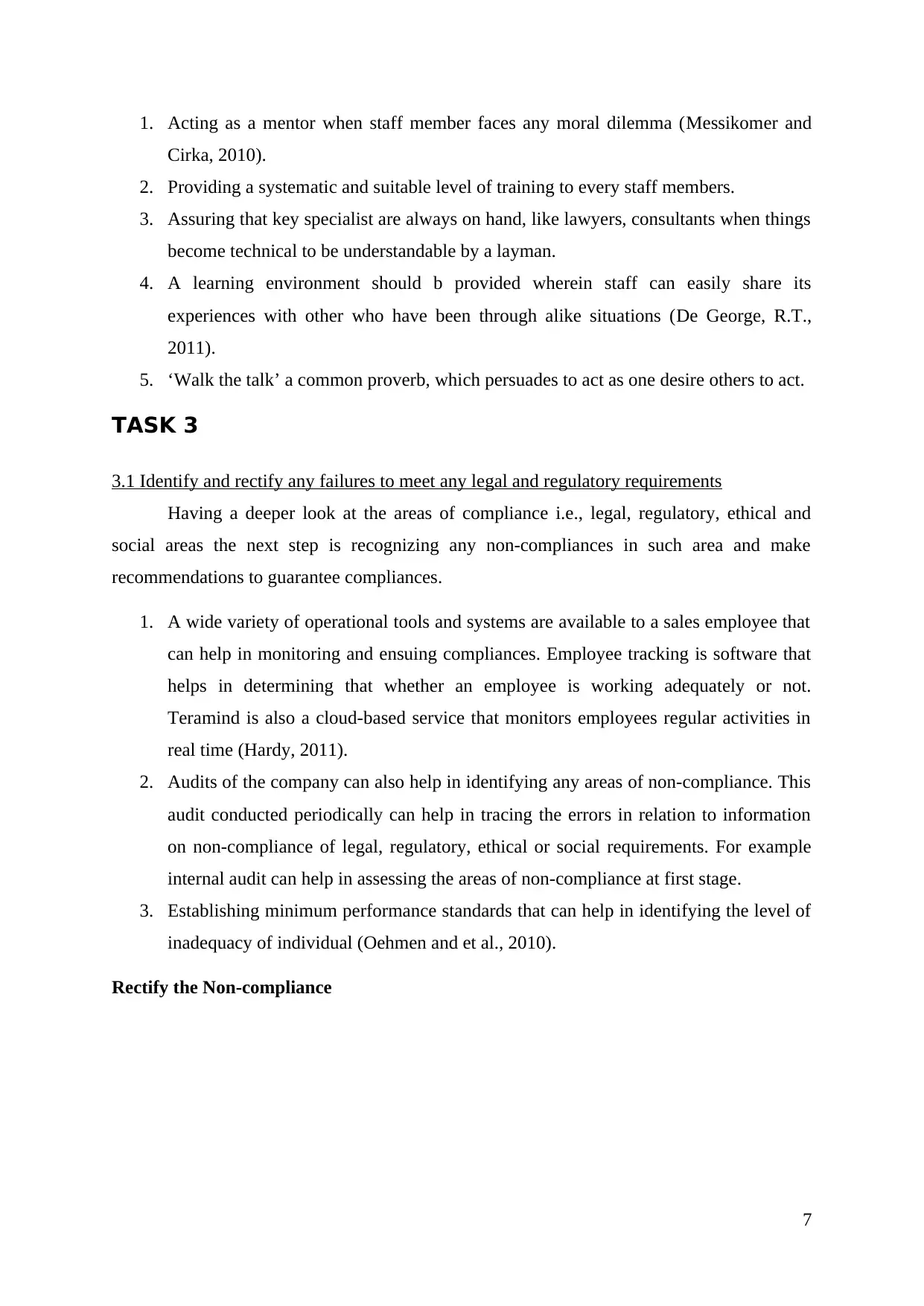
1. Acting as a mentor when staff member faces any moral dilemma (Messikomer and
Cirka, 2010).
2. Providing a systematic and suitable level of training to every staff members.
3. Assuring that key specialist are always on hand, like lawyers, consultants when things
become technical to be understandable by a layman.
4. A learning environment should b provided wherein staff can easily share its
experiences with other who have been through alike situations (De George, R.T.,
2011).
5. ‘Walk the talk’ a common proverb, which persuades to act as one desire others to act.
TASK 3
3.1 Identify and rectify any failures to meet any legal and regulatory requirements
Having a deeper look at the areas of compliance i.e., legal, regulatory, ethical and
social areas the next step is recognizing any non-compliances in such area and make
recommendations to guarantee compliances.
1. A wide variety of operational tools and systems are available to a sales employee that
can help in monitoring and ensuing compliances. Employee tracking is software that
helps in determining that whether an employee is working adequately or not.
Teramind is also a cloud-based service that monitors employees regular activities in
real time (Hardy, 2011).
2. Audits of the company can also help in identifying any areas of non-compliance. This
audit conducted periodically can help in tracing the errors in relation to information
on non-compliance of legal, regulatory, ethical or social requirements. For example
internal audit can help in assessing the areas of non-compliance at first stage.
3. Establishing minimum performance standards that can help in identifying the level of
inadequacy of individual (Oehmen and et al., 2010).
Rectify the Non-compliance
7
Cirka, 2010).
2. Providing a systematic and suitable level of training to every staff members.
3. Assuring that key specialist are always on hand, like lawyers, consultants when things
become technical to be understandable by a layman.
4. A learning environment should b provided wherein staff can easily share its
experiences with other who have been through alike situations (De George, R.T.,
2011).
5. ‘Walk the talk’ a common proverb, which persuades to act as one desire others to act.
TASK 3
3.1 Identify and rectify any failures to meet any legal and regulatory requirements
Having a deeper look at the areas of compliance i.e., legal, regulatory, ethical and
social areas the next step is recognizing any non-compliances in such area and make
recommendations to guarantee compliances.
1. A wide variety of operational tools and systems are available to a sales employee that
can help in monitoring and ensuing compliances. Employee tracking is software that
helps in determining that whether an employee is working adequately or not.
Teramind is also a cloud-based service that monitors employees regular activities in
real time (Hardy, 2011).
2. Audits of the company can also help in identifying any areas of non-compliance. This
audit conducted periodically can help in tracing the errors in relation to information
on non-compliance of legal, regulatory, ethical or social requirements. For example
internal audit can help in assessing the areas of non-compliance at first stage.
3. Establishing minimum performance standards that can help in identifying the level of
inadequacy of individual (Oehmen and et al., 2010).
Rectify the Non-compliance
7
Paraphrase This Document
Need a fresh take? Get an instant paraphrase of this document with our AI Paraphraser
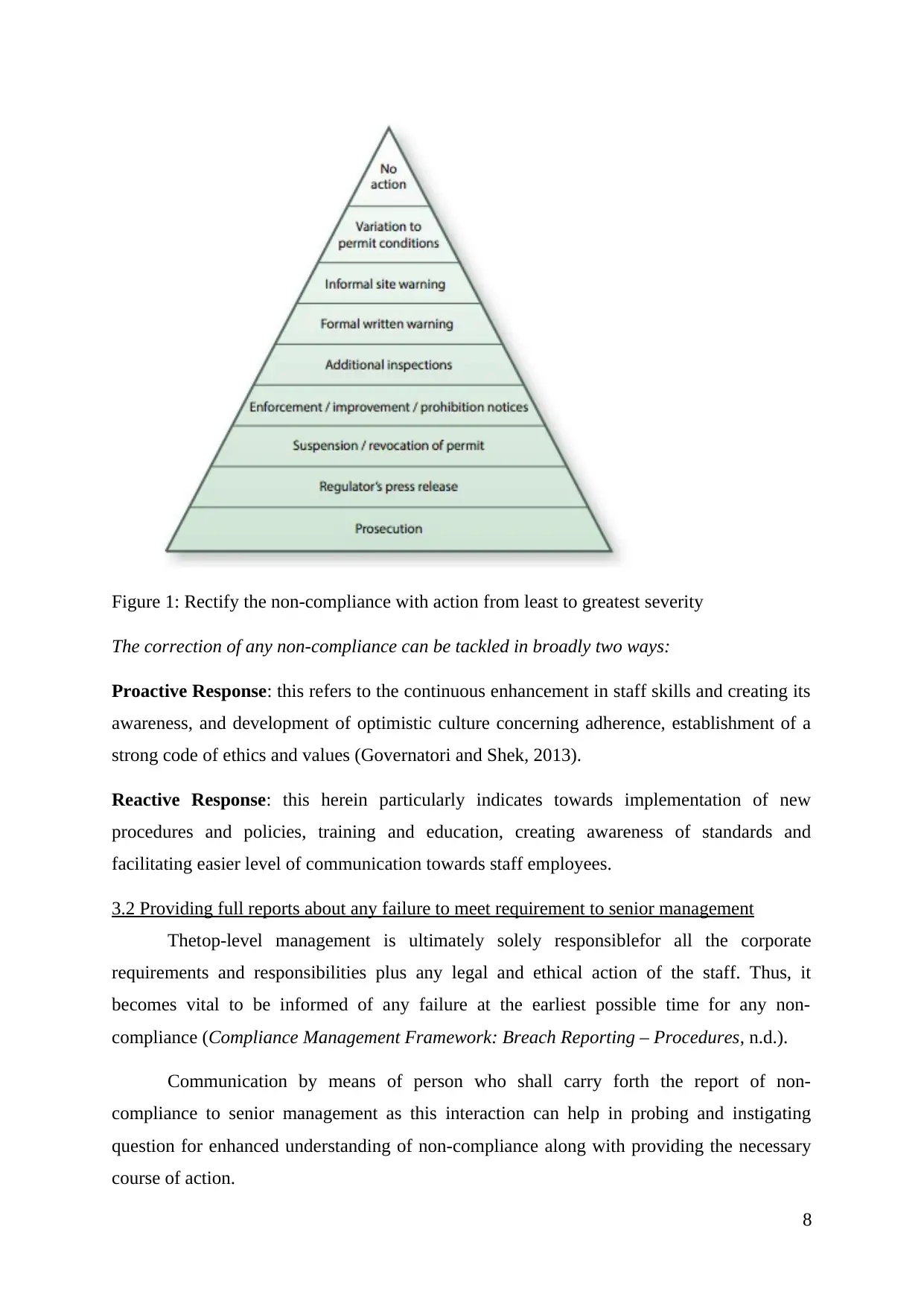
Figure 1: Rectify the non-compliance with action from least to greatest severity
The correction of any non-compliance can be tackled in broadly two ways:
Proactive Response: this refers to the continuous enhancement in staff skills and creating its
awareness, and development of optimistic culture concerning adherence, establishment of a
strong code of ethics and values (Governatori and Shek, 2013).
Reactive Response: this herein particularly indicates towards implementation of new
procedures and policies, training and education, creating awareness of standards and
facilitating easier level of communication towards staff employees.
3.2 Providing full reports about any failure to meet requirement to senior management
Thetop-level management is ultimately solely responsiblefor all the corporate
requirements and responsibilities plus any legal and ethical action of the staff. Thus, it
becomes vital to be informed of any failure at the earliest possible time for any non-
compliance (Compliance Management Framework: Breach Reporting – Procedures, n.d.).
Communication by means of person who shall carry forth the report of non-
compliance to senior management as this interaction can help in probing and instigating
question for enhanced understanding of non-compliance along with providing the necessary
course of action.
8
The correction of any non-compliance can be tackled in broadly two ways:
Proactive Response: this refers to the continuous enhancement in staff skills and creating its
awareness, and development of optimistic culture concerning adherence, establishment of a
strong code of ethics and values (Governatori and Shek, 2013).
Reactive Response: this herein particularly indicates towards implementation of new
procedures and policies, training and education, creating awareness of standards and
facilitating easier level of communication towards staff employees.
3.2 Providing full reports about any failure to meet requirement to senior management
Thetop-level management is ultimately solely responsiblefor all the corporate
requirements and responsibilities plus any legal and ethical action of the staff. Thus, it
becomes vital to be informed of any failure at the earliest possible time for any non-
compliance (Compliance Management Framework: Breach Reporting – Procedures, n.d.).
Communication by means of person who shall carry forth the report of non-
compliance to senior management as this interaction can help in probing and instigating
question for enhanced understanding of non-compliance along with providing the necessary
course of action.
8
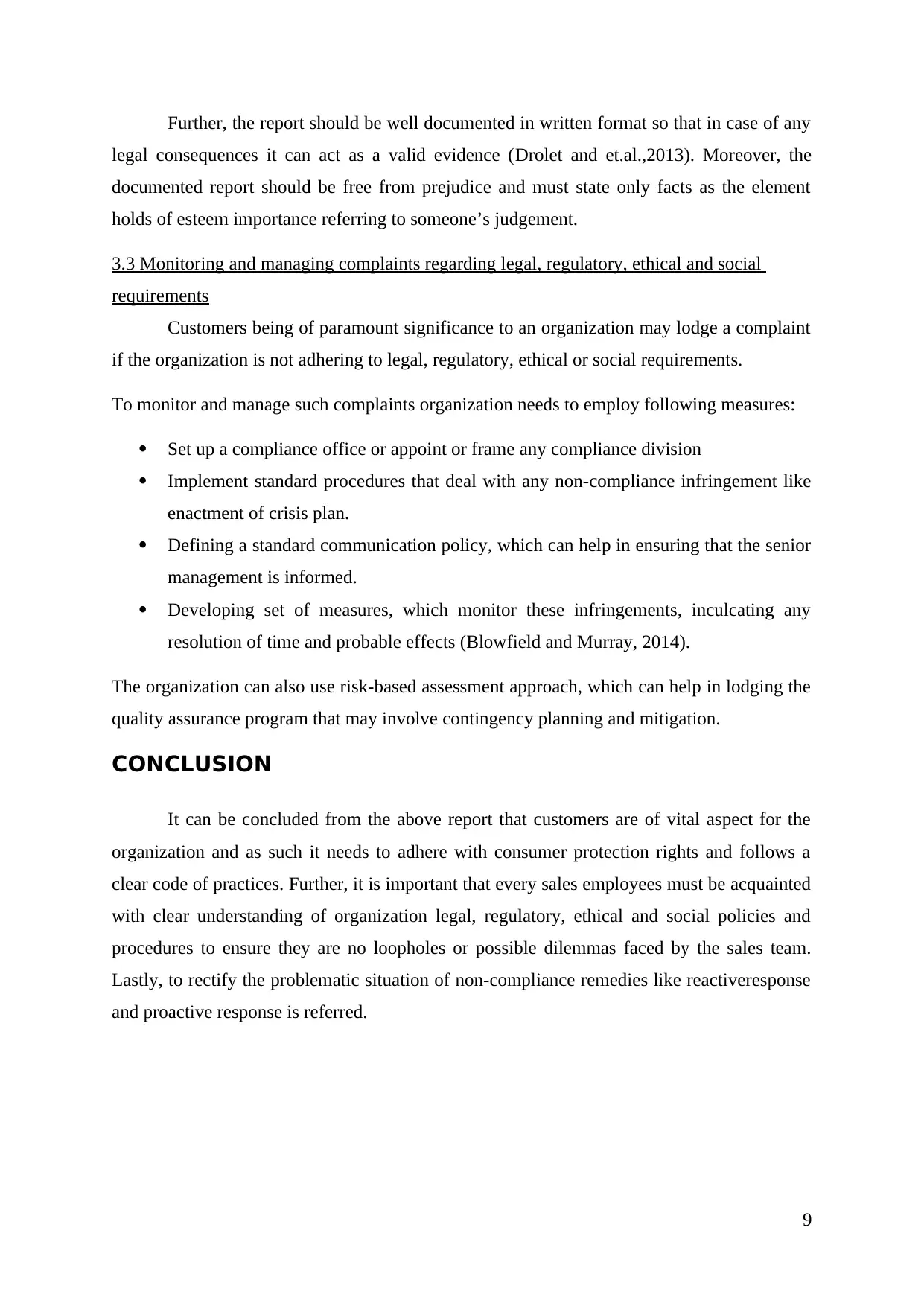
Further, the report should be well documented in written format so that in case of any
legal consequences it can act as a valid evidence (Drolet and et.al.,2013). Moreover, the
documented report should be free from prejudice and must state only facts as the element
holds of esteem importance referring to someone’s judgement.
3.3 Monitoring and managing complaints regarding legal, regulatory, ethical and social
requirements
Customers being of paramount significance to an organization may lodge a complaint
if the organization is not adhering to legal, regulatory, ethical or social requirements.
To monitor and manage such complaints organization needs to employ following measures:
Set up a compliance office or appoint or frame any compliance division
Implement standard procedures that deal with any non-compliance infringement like
enactment of crisis plan.
Defining a standard communication policy, which can help in ensuring that the senior
management is informed.
Developing set of measures, which monitor these infringements, inculcating any
resolution of time and probable effects (Blowfield and Murray, 2014).
The organization can also use risk-based assessment approach, which can help in lodging the
quality assurance program that may involve contingency planning and mitigation.
CONCLUSION
It can be concluded from the above report that customers are of vital aspect for the
organization and as such it needs to adhere with consumer protection rights and follows a
clear code of practices. Further, it is important that every sales employees must be acquainted
with clear understanding of organization legal, regulatory, ethical and social policies and
procedures to ensure they are no loopholes or possible dilemmas faced by the sales team.
Lastly, to rectify the problematic situation of non-compliance remedies like reactiveresponse
and proactive response is referred.
9
legal consequences it can act as a valid evidence (Drolet and et.al.,2013). Moreover, the
documented report should be free from prejudice and must state only facts as the element
holds of esteem importance referring to someone’s judgement.
3.3 Monitoring and managing complaints regarding legal, regulatory, ethical and social
requirements
Customers being of paramount significance to an organization may lodge a complaint
if the organization is not adhering to legal, regulatory, ethical or social requirements.
To monitor and manage such complaints organization needs to employ following measures:
Set up a compliance office or appoint or frame any compliance division
Implement standard procedures that deal with any non-compliance infringement like
enactment of crisis plan.
Defining a standard communication policy, which can help in ensuring that the senior
management is informed.
Developing set of measures, which monitor these infringements, inculcating any
resolution of time and probable effects (Blowfield and Murray, 2014).
The organization can also use risk-based assessment approach, which can help in lodging the
quality assurance program that may involve contingency planning and mitigation.
CONCLUSION
It can be concluded from the above report that customers are of vital aspect for the
organization and as such it needs to adhere with consumer protection rights and follows a
clear code of practices. Further, it is important that every sales employees must be acquainted
with clear understanding of organization legal, regulatory, ethical and social policies and
procedures to ensure they are no loopholes or possible dilemmas faced by the sales team.
Lastly, to rectify the problematic situation of non-compliance remedies like reactiveresponse
and proactive response is referred.
9
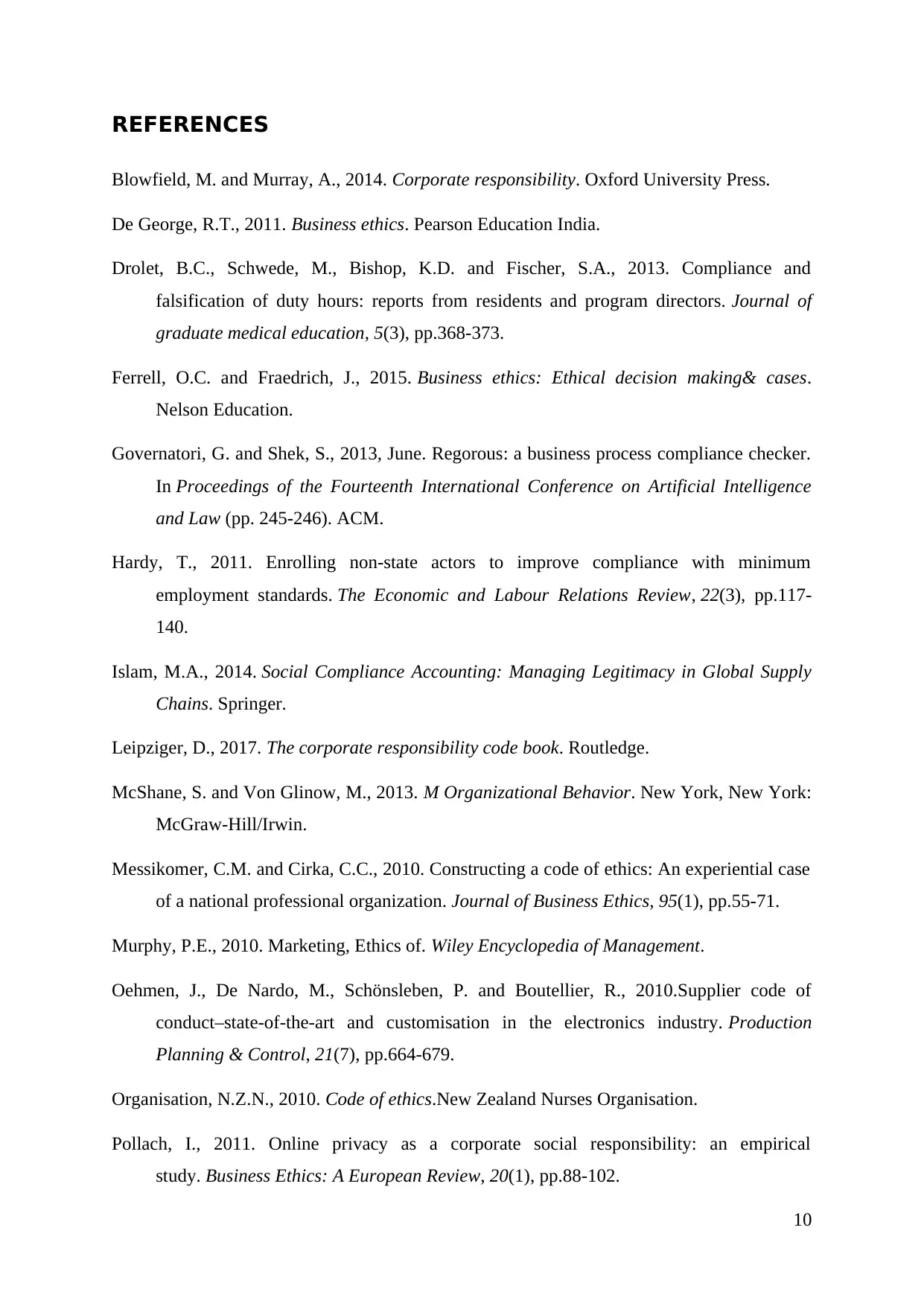
REFERENCES
Blowfield, M. and Murray, A., 2014. Corporate responsibility. Oxford University Press.
De George, R.T., 2011. Business ethics. Pearson Education India.
Drolet, B.C., Schwede, M., Bishop, K.D. and Fischer, S.A., 2013. Compliance and
falsification of duty hours: reports from residents and program directors. Journal of
graduate medical education, 5(3), pp.368-373.
Ferrell, O.C. and Fraedrich, J., 2015. Business ethics: Ethical decision making& cases.
Nelson Education.
Governatori, G. and Shek, S., 2013, June. Regorous: a business process compliance checker.
In Proceedings of the Fourteenth International Conference on Artificial Intelligence
and Law (pp. 245-246). ACM.
Hardy, T., 2011. Enrolling non-state actors to improve compliance with minimum
employment standards. The Economic and Labour Relations Review, 22(3), pp.117-
140.
Islam, M.A., 2014. Social Compliance Accounting: Managing Legitimacy in Global Supply
Chains. Springer.
Leipziger, D., 2017. The corporate responsibility code book. Routledge.
McShane, S. and Von Glinow, M., 2013. M Organizational Behavior. New York, New York:
McGraw-Hill/Irwin.
Messikomer, C.M. and Cirka, C.C., 2010. Constructing a code of ethics: An experiential case
of a national professional organization. Journal of Business Ethics, 95(1), pp.55-71.
Murphy, P.E., 2010. Marketing, Ethics of. Wiley Encyclopedia of Management.
Oehmen, J., De Nardo, M., Schönsleben, P. and Boutellier, R., 2010.Supplier code of
conduct–state-of-the-art and customisation in the electronics industry. Production
Planning & Control, 21(7), pp.664-679.
Organisation, N.Z.N., 2010. Code of ethics.New Zealand Nurses Organisation.
Pollach, I., 2011. Online privacy as a corporate social responsibility: an empirical
study. Business Ethics: A European Review, 20(1), pp.88-102.
10
Blowfield, M. and Murray, A., 2014. Corporate responsibility. Oxford University Press.
De George, R.T., 2011. Business ethics. Pearson Education India.
Drolet, B.C., Schwede, M., Bishop, K.D. and Fischer, S.A., 2013. Compliance and
falsification of duty hours: reports from residents and program directors. Journal of
graduate medical education, 5(3), pp.368-373.
Ferrell, O.C. and Fraedrich, J., 2015. Business ethics: Ethical decision making& cases.
Nelson Education.
Governatori, G. and Shek, S., 2013, June. Regorous: a business process compliance checker.
In Proceedings of the Fourteenth International Conference on Artificial Intelligence
and Law (pp. 245-246). ACM.
Hardy, T., 2011. Enrolling non-state actors to improve compliance with minimum
employment standards. The Economic and Labour Relations Review, 22(3), pp.117-
140.
Islam, M.A., 2014. Social Compliance Accounting: Managing Legitimacy in Global Supply
Chains. Springer.
Leipziger, D., 2017. The corporate responsibility code book. Routledge.
McShane, S. and Von Glinow, M., 2013. M Organizational Behavior. New York, New York:
McGraw-Hill/Irwin.
Messikomer, C.M. and Cirka, C.C., 2010. Constructing a code of ethics: An experiential case
of a national professional organization. Journal of Business Ethics, 95(1), pp.55-71.
Murphy, P.E., 2010. Marketing, Ethics of. Wiley Encyclopedia of Management.
Oehmen, J., De Nardo, M., Schönsleben, P. and Boutellier, R., 2010.Supplier code of
conduct–state-of-the-art and customisation in the electronics industry. Production
Planning & Control, 21(7), pp.664-679.
Organisation, N.Z.N., 2010. Code of ethics.New Zealand Nurses Organisation.
Pollach, I., 2011. Online privacy as a corporate social responsibility: an empirical
study. Business Ethics: A European Review, 20(1), pp.88-102.
10
Secure Best Marks with AI Grader
Need help grading? Try our AI Grader for instant feedback on your assignments.
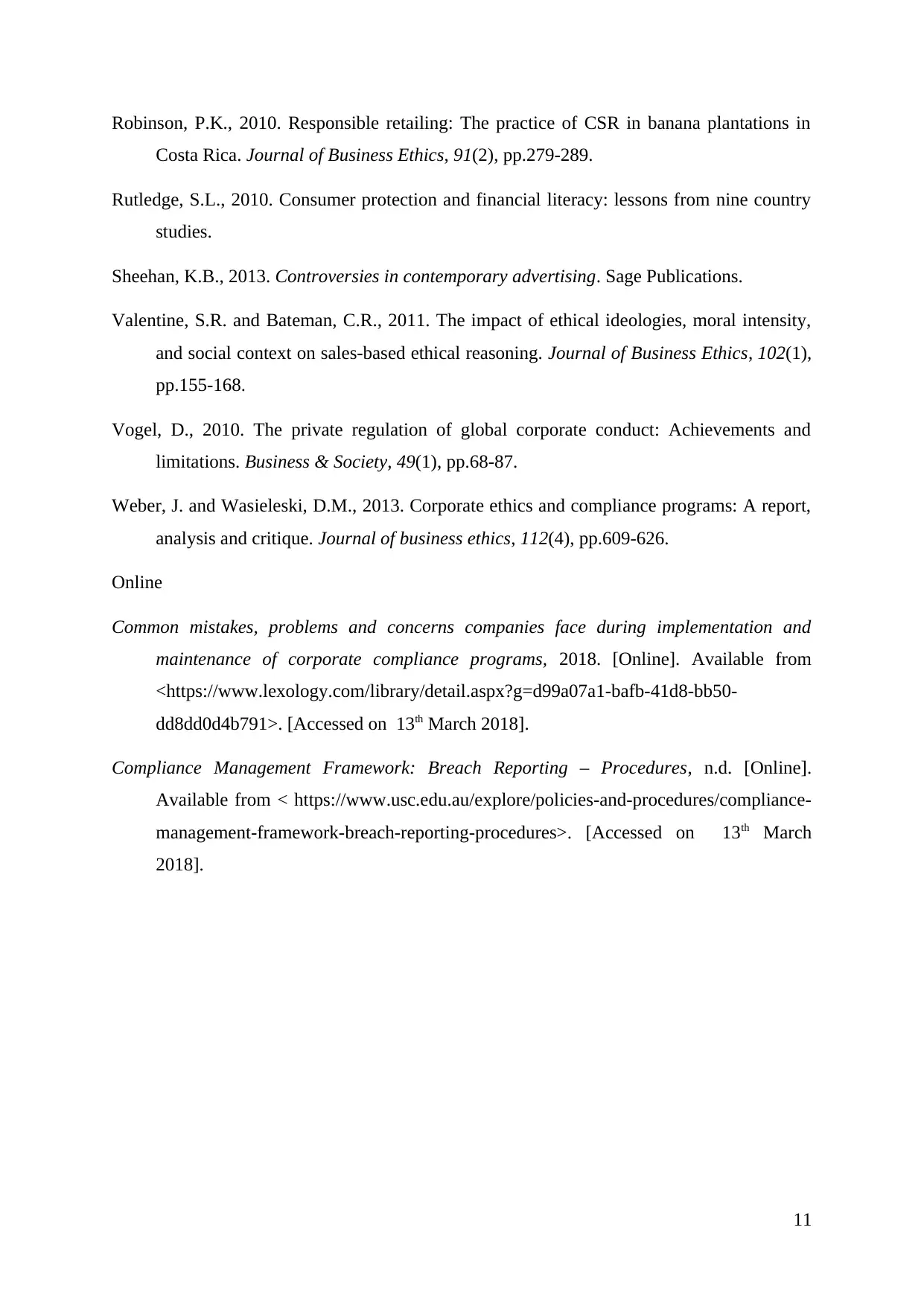
Robinson, P.K., 2010. Responsible retailing: The practice of CSR in banana plantations in
Costa Rica. Journal of Business Ethics, 91(2), pp.279-289.
Rutledge, S.L., 2010. Consumer protection and financial literacy: lessons from nine country
studies.
Sheehan, K.B., 2013. Controversies in contemporary advertising. Sage Publications.
Valentine, S.R. and Bateman, C.R., 2011. The impact of ethical ideologies, moral intensity,
and social context on sales-based ethical reasoning. Journal of Business Ethics, 102(1),
pp.155-168.
Vogel, D., 2010. The private regulation of global corporate conduct: Achievements and
limitations. Business & Society, 49(1), pp.68-87.
Weber, J. and Wasieleski, D.M., 2013. Corporate ethics and compliance programs: A report,
analysis and critique. Journal of business ethics, 112(4), pp.609-626.
Online
Common mistakes, problems and concerns companies face during implementation and
maintenance of corporate compliance programs, 2018. [Online]. Available from
<https://www.lexology.com/library/detail.aspx?g=d99a07a1-bafb-41d8-bb50-
dd8dd0d4b791>. [Accessed on 13th March 2018].
Compliance Management Framework: Breach Reporting – Procedures, n.d. [Online].
Available from < https://www.usc.edu.au/explore/policies-and-procedures/compliance-
management-framework-breach-reporting-procedures>. [Accessed on 13th March
2018].
11
Costa Rica. Journal of Business Ethics, 91(2), pp.279-289.
Rutledge, S.L., 2010. Consumer protection and financial literacy: lessons from nine country
studies.
Sheehan, K.B., 2013. Controversies in contemporary advertising. Sage Publications.
Valentine, S.R. and Bateman, C.R., 2011. The impact of ethical ideologies, moral intensity,
and social context on sales-based ethical reasoning. Journal of Business Ethics, 102(1),
pp.155-168.
Vogel, D., 2010. The private regulation of global corporate conduct: Achievements and
limitations. Business & Society, 49(1), pp.68-87.
Weber, J. and Wasieleski, D.M., 2013. Corporate ethics and compliance programs: A report,
analysis and critique. Journal of business ethics, 112(4), pp.609-626.
Online
Common mistakes, problems and concerns companies face during implementation and
maintenance of corporate compliance programs, 2018. [Online]. Available from
<https://www.lexology.com/library/detail.aspx?g=d99a07a1-bafb-41d8-bb50-
dd8dd0d4b791>. [Accessed on 13th March 2018].
Compliance Management Framework: Breach Reporting – Procedures, n.d. [Online].
Available from < https://www.usc.edu.au/explore/policies-and-procedures/compliance-
management-framework-breach-reporting-procedures>. [Accessed on 13th March
2018].
11
1 out of 11
Your All-in-One AI-Powered Toolkit for Academic Success.
+13062052269
info@desklib.com
Available 24*7 on WhatsApp / Email
![[object Object]](/_next/static/media/star-bottom.7253800d.svg)
Unlock your academic potential
© 2024 | Zucol Services PVT LTD | All rights reserved.





